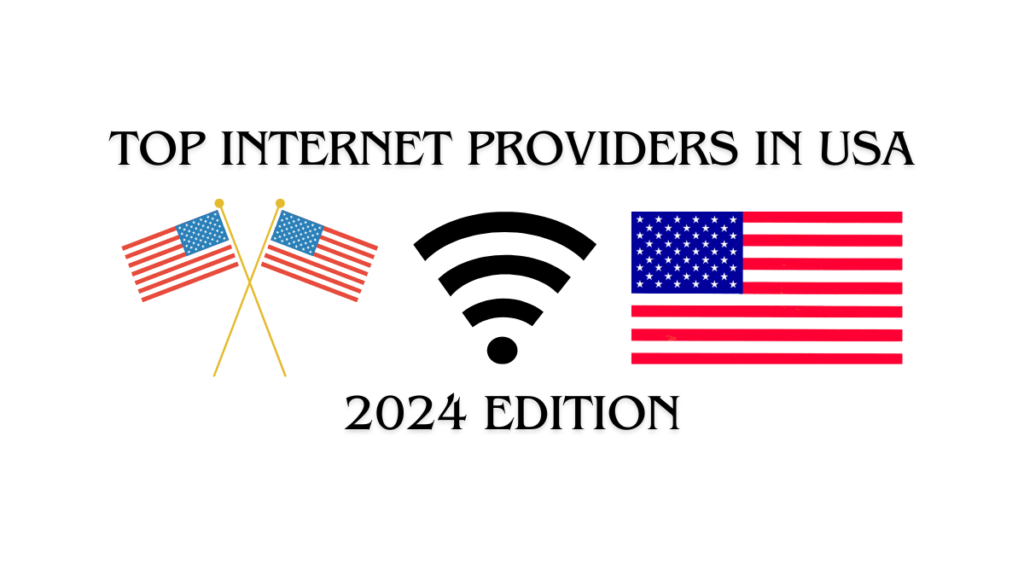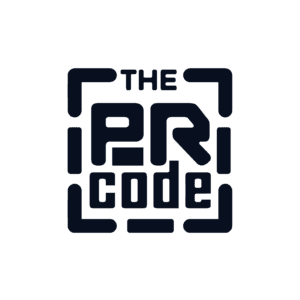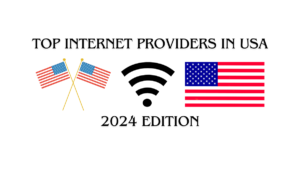
Top Internet Providers in USA 2024 Edition
Top Internet Providers in USA: In the age of information, a reliable internet connection is no longer a luxury, it’s a necessity. Whether you’re streaming movies, working remotely, or staying connected with loved ones, having access to high-speed internet is crucial. But with a vast array of internet service providers (ISPs) operating across the United States, choosing the right one can be daunting.
This blog post aims to be your one-stop guide, navigating the sea of options and highlighting the top internet providers in the USA. We’ll delve into their offerings, strengths, and potential drawbacks to help you make an informed decision.
Table of Contents: Top Internet Providers in USA

Understanding the Landscape:
Before diving in, it’s essential to understand the different types of internet connections available:
- Fiber Optic: Renowned for its speed and reliability, fiber optic cables transmit data using light pulses. While offering unmatched speed potential, fiber optic infrastructure isn’t readily available everywhere, and it can be more expensive than other options.
- Cable: Utilizing the same infrastructure as cable television, cable internet offers good speeds and widespread availability. However, its performance can be impacted by network congestion during peak usage times.
- DSL: This technology delivers internet access using existing telephone lines. While readily available, DSL internet speeds are generally the slowest among the options mentioned here.
- Satellite: This option transmits data signals via satellites orbiting Earth. While it provides internet access to remote areas, satellite internet suffers from high latency and potential weather impacts.
Top Contenders in the ISP Arena:
Now that we’ve laid the groundwork, let’s explore the top internet providers in the USA categorized by the type of connection they offer:
1. Fiber Optic Providers:
- Verizon Fios: This giant in the telecommunications industry boasts the most extensive fiber optic network in the USA. Fios offers blazing-fast speeds, typically ranging from 300 Mbps to 2 Gbps, making it ideal for data-intensive tasks like online gaming and video conferencing. Additionally, Verizon Fios is known for its exceptional customer service and reliable network performance. However, its availability is limited, primarily concentrated in major metropolitan areas, and it can be pricier than other options.
- Google Fiber: While not as widespread as Verizon Fios, Google Fiber is rapidly expanding its reach, offering incredibly fast and symmetrical speed options (download and upload speeds are the same). Google Fiber prioritizes competitive pricing and transparent contracts, making it an attractive option in areas where it’s available.
2. Cable Providers:
- Spectrum: Formerly known as Time Warner Cable, Spectrum is a major player in the cable internet market, offering widespread availability across the USA. They offer a range of speed options, typically ranging from 200 Mbps to 1 Gbps, making them suitable for most home internet needs. Spectrum is known for its bundled packages, offering internet, cable TV, and home phone services at competitive prices. However, cable internet can experience fluctuations in speed due to network congestion during peak usage times.
- Xfinity from Comcast: This major cable provider boasts a large network footprint across the USA. Xfinity offers a variety of packages, including internet speeds ranging from 25 Mbps to 10 Gbps. High-speed internet plans from Xfinity cater to users with advanced needs, particularly gamers and content creators. However, similar to Spectrum, Xfinity internet can experience speed fluctuations due to network congestion.
3. DSL Providers:
- AT&T Internet: This telecommunications giant offers DSL internet access in many areas where fiber optic or cable options are unavailable. While not the fastest option, AT&T offers a range of DSL plans, typically ranging from 25 Mbps to 100 Mbps, making them suitable for basic internet needs. AT&T DSL is known for its nationwide availability and competitive pricing, especially for bundled packages that include internet and phone services. However, DSL internet is significantly slower than other options and may not be suitable for heavy internet users.
4. Satellite Providers:
- HughesNet: This leading satellite internet provider offers service to even the most remote areas in the USA. However, satellite internet comes with significant drawbacks, including:
- Latency: Satellite signals travel a long distance, resulting in higher latency compared to other options. This can hinder online gaming and video conferencing experiences.
- Weather Dependence: Satellite signals can be disrupted by heavy rain, snowfall, or other weather events.
- Data Caps: HughesNet enforces data caps on their plans, limiting the amount of data users can consume every month. Exceeding the cap can result in throttling or additional charges.
Making the Right Choice:
Choosing the right internet provider boils down to identifying your specific needs and priorities. Here are some key factors to consider:
- Location: Availability plays a crucial role. Check if the providers you’re considering offer service in your area and what types of connections are available (fiber optic, cable, DSL, etc.).
- Speed: Evaluate your internet needs. Basic web browsing and email might be satisfied with lower speeds (25-50 Mbps), while streaming, gaming, and downloading large files require faster options (100 Mbps and above).
- Price: Compare different plans and packages offered by various providers. Consider bundled services like cable TV or phone if you find them cost-effective for your needs. Be mindful of additional fees like equipment rental or installation charges.
- Customer Service: Research the reputation of different providers regarding customer service. Check online reviews and ratings to understand how providers handle potential issues and inquiries.
- Data Caps and Contracts: Be aware of data caps, which limit the amount of data you can use per month. Exceeding the cap can lead to throttling (reduced speeds) or additional charges. Similarly, understand the contract duration and potential early termination fees associated with various plans.

Additional Tips:
- Utilize online resources like the FCC’s Broadband Map (broadbandmap.fcc.gov) to see which providers offer service in your area.
- Negotiate with your chosen provider for better deals or bundled packages that fit your budget.
- Read reviews and compare customer service experiences before making your final decision.
Remember, choosing the right internet provider requires a bit of research and consideration. By understanding your needs, comparing options, and utilizing the tips provided in this blog post, you can make an informed decision that ensures you have a reliable and high-speed internet connection to stay connected and productive in today’s digital world.
TAGS: Top Internet Providers in USA, Top Internet Providers in USA, Top Internet Providers in USA, Top Internet Providers in USA, Top Internet Providers in USA, Top Internet Providers in USA, Top Internet Providers in USA, Top Internet Providers in USA, Top Internet Providers in USA, Top Internet Providers in USA, Top Internet Providers in USA, Top Internet Providers in USA, Top Internet Providers in USA, Top Internet Providers in USA, Top Internet Providers in USA, Top Internet Providers in USA





